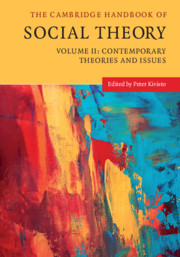Book contents
- The Cambridge Handbook of Social Theory
- The Cambridge Handbook of Social Theory
- Copyright page
- Contents
- Figures
- Tables
- Contributors
- Preface
- 1 Rational Choice Theory and Methodological Individualism
- 2 Network Theories
- 3 Cultural Sociology
- 4 Identity
- 5 Emotions Theory
- 6 Theorizing Sex/Gender: Feminist Social Theory
- 7 Intersectionality as Critical Social Theory
- 8 Modernity
- 9 Realism
- 10 Globalization: Not Good, Bad, or Over
- 11 Time/Space
- 12 Social Theory in the Anthropocene: Ecological Crisis and Renewal
- 13 Embodiment
- 14 Sexualities
- 15 Multiculturalism
- 16 Risk
- 17 Trust and the Variety of Its Bases
- 18 Unities Within Conflict: Mapping Biology’s Relevance to Sociological Theory
- 19 Civil Society
- 20 Social Movements: Sequences vs Fuzzy Temporality
- 21 Immigration
- Index
- References
6 - Theorizing Sex/Gender: Feminist Social Theory
Published online by Cambridge University Press: 03 December 2020
- The Cambridge Handbook of Social Theory
- The Cambridge Handbook of Social Theory
- Copyright page
- Contents
- Figures
- Tables
- Contributors
- Preface
- 1 Rational Choice Theory and Methodological Individualism
- 2 Network Theories
- 3 Cultural Sociology
- 4 Identity
- 5 Emotions Theory
- 6 Theorizing Sex/Gender: Feminist Social Theory
- 7 Intersectionality as Critical Social Theory
- 8 Modernity
- 9 Realism
- 10 Globalization: Not Good, Bad, or Over
- 11 Time/Space
- 12 Social Theory in the Anthropocene: Ecological Crisis and Renewal
- 13 Embodiment
- 14 Sexualities
- 15 Multiculturalism
- 16 Risk
- 17 Trust and the Variety of Its Bases
- 18 Unities Within Conflict: Mapping Biology’s Relevance to Sociological Theory
- 19 Civil Society
- 20 Social Movements: Sequences vs Fuzzy Temporality
- 21 Immigration
- Index
- References
Summary
Feminist theory operates in a ‘dual register’, characterized by the interrogation of mainstream theory, noted for its gender-blindness, and a reflexive auto-critique in which core assumptions of feminist thought are constantly interrogated.Developing the concept of ‘gender’ as a central structuring force in society has been an important theoretical tool. Among the issues addressed in this chapter are the deconstruction of the sex/gender distinction, postcolonial and postmodernist feminist critiques, theories of intersectionality, the emergence of the study of new materialism, and contributions made by transgender theory.
Feminist theory, intersectionality, postcolonial feminism, sex/gender, transgender theory
Shelley Budgeon is a Senior Lecturer in Sociology at the University of Birmingham.Her research analyzes how the constitution of gender relations and gender identification are being affected by sociopolitical change.This includes the formation of contemporary femininity and gendered subjectivities, the constitutive relations between different femininities and feminisms in late modernity, and the dynamics of postfeminist neoliberalism.
- Type
- Chapter
- Information
- The Cambridge Handbook of Social Theory , pp. 98 - 119Publisher: Cambridge University PressPrint publication year: 2020

